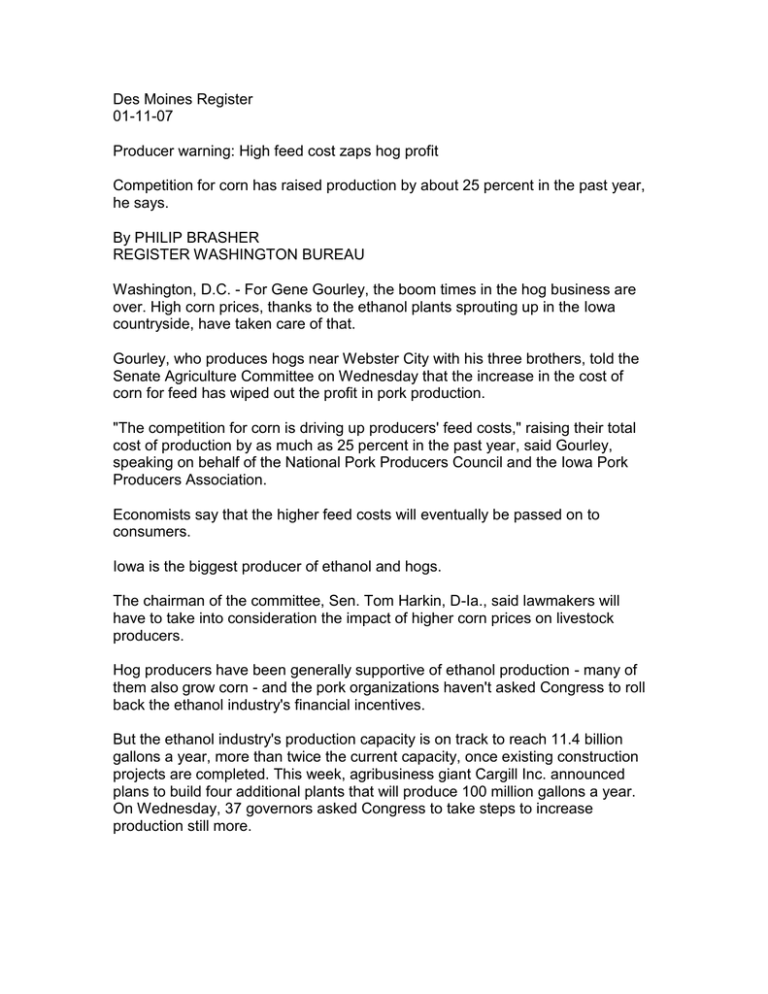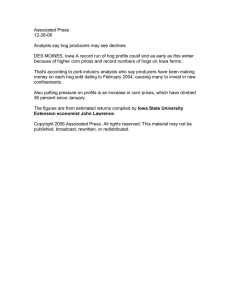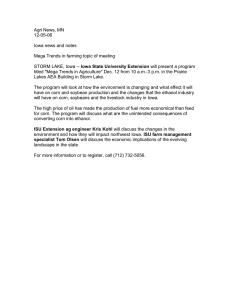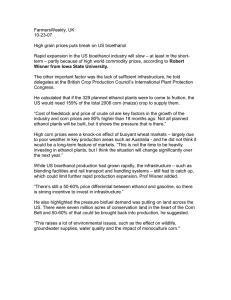Des Moines Register 01-11-07 Producer warning: High feed cost zaps hog profit
advertisement

Des Moines Register 01-11-07 Producer warning: High feed cost zaps hog profit Competition for corn has raised production by about 25 percent in the past year, he says. By PHILIP BRASHER REGISTER WASHINGTON BUREAU Washington, D.C. - For Gene Gourley, the boom times in the hog business are over. High corn prices, thanks to the ethanol plants sprouting up in the Iowa countryside, have taken care of that. Gourley, who produces hogs near Webster City with his three brothers, told the Senate Agriculture Committee on Wednesday that the increase in the cost of corn for feed has wiped out the profit in pork production. "The competition for corn is driving up producers' feed costs," raising their total cost of production by as much as 25 percent in the past year, said Gourley, speaking on behalf of the National Pork Producers Council and the Iowa Pork Producers Association. Economists say that the higher feed costs will eventually be passed on to consumers. Iowa is the biggest producer of ethanol and hogs. The chairman of the committee, Sen. Tom Harkin, D-Ia., said lawmakers will have to take into consideration the impact of higher corn prices on livestock producers. Hog producers have been generally supportive of ethanol production - many of them also grow corn - and the pork organizations haven't asked Congress to roll back the ethanol industry's financial incentives. But the ethanol industry's production capacity is on track to reach 11.4 billion gallons a year, more than twice the current capacity, once existing construction projects are completed. This week, agribusiness giant Cargill Inc. announced plans to build four additional plants that will produce 100 million gallons a year. On Wednesday, 37 governors asked Congress to take steps to increase production still more. The Governor's Ethanol Coalition proposed that Congress require use of 12 billion gallons of ethanol a year by 2010, more than double the industry's current capacity, and set higher targets in 2015 and 2025. Those goals are designed to stimulate production of ethanol from sources that are more plentiful than corn. Currently, ethanol is much cheaper to produce from corn. Seven ethanol plants have been built within 50 miles of the Gourleys in northcentral Iowa in the past three years and an eighth is being built, he said. The brothers produce 60,000 hogs a year. They grow about one-third of the 750,000 bushels of corn the hogs consume annually. In the past year, the cost of the corn for feed has gone up about $10 per hog, he said. "Long term, I won't be able to run in the red and survive," he said after the hearing. Iowa hog producers have turned a profit every month for the past three years, but analysts say that could end this winter as corn prices climb. Ethanol plants sell a by-product called distillers' grains that is widely used for cattle feed. Hogs can only eat it in limited amounts. Consumers will start to see higher prices once hog producers go out of business and pork supplies tighten, said John Lawrence, an economist at Iowa State University. Reporter Philip Brasher can be reached at (202) 906-8138 or pbrasher@dmreg.com






